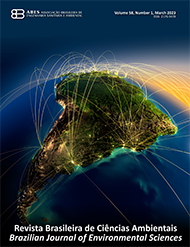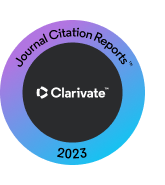Pathogenicity of bacteria and viruses to Spodoptera frugiperda (Lepidoptera: Noctuidae)
DOI:
https://doi.org/10.5327/Z2176-94781952Keywords:
fall armyworm; integrated pest management; sustainable agriculture.Abstract
Combining integrated pest management and biological control has been an effective, economical, and sustainable strategy for controlling agricultural pests. The larvae of Spodoptera frugiperda, apest of several crops, cause financial losses to the agribusiness sector, and entomopathogens have been widely used for the biological control of this species. Therefore, the objective of this study was to evaluate the pathogenicity of bacteria and viruses for the control of S. frugiperda under laboratory conditions. Two bioassays were conducted in a completely randomized design, one using second-instar and other using third-instar larvae, with six treatments and five replications. The entomopathogens used were S. frugiperdaMultiple nucleopolyhedrovirus (SfMNPV), Autographa californica multiple nucleopolyhedrovirus (AcMNPV), Bacillus subtilis, B. thuringiensis subsp. thoworthy, and B. thuringiensis subsp. kurstaki. Mortality was assessed daily until the end of the larval cycle. Analysis of variance (F-test) was applied, followed by mean comparison through the Scott-Knott test at a 5% significance level. The efficacy of the entomopathogens as bioinsecticides was evaluated using Abbott’s formula. Overall, the most effective entomopathogens for controlling second-instar S. frugiperdalarvae were SfMNPV and B. subtilis, resulting in 100% control, whereas AcMNPV was the most effective against third-instar larvae, showing maximum lethality in 76.67% of samples.
Downloads
References
Abbott, W.S., 1925. A method of computing the effectiveness of an insecticide. Journal of Economic Entomology, v. 18, (2), 265-267. https://doi.org/10.1093/jee/18.2.265a
Agrofit, 2023. Sistema de registro de agrotóxicos do Ministério da Agricultura (Accessed January 11, 2024) at:. https://extranet. agricultura.gov.br/agrofit_cons/principal_agrofit_cons
Arakere, U.C.; Jagannath, S.; Krishnamurthy, S.; Chowdappa, S.; Konappa, N., 2022. Microbial bio-pesticide as sustainable solution for management of pests: achievements and prospects. Biopesticides, v. 2, 183-200. https://doi.org/10.1016/B978-0-12-823355-9.00016-X
Araújo, I.S.; de Oliveira, G.M.; de Lacerda, L.B.; de Luna Batista, J.; Lopes, G.N., 2019. Perspectivas atuais da utilização de bioinseticidas em Spodoptera frugiperda (Lepidoptera: Noctuidae). Revista Brasileira de Meio Ambiente, v. 7, (3), 1-8. https://doi.org/10.5281/zenodo.3575253
Crickmore, N.; Berry, C.; Panneerselvam, S.; Mishra, R.; Connor, T.R.; Bonning, B.C., 2021. A structure-based nomenclature for Bacillus thuringiensis and other bacteria-derived pesticidal proteins. Journal of Invertebrate Pathology, v. 186, e107438. https://doi.org/10.1016/j.jip.2020.107438
De Jesus, J.C.; Silva, B.D.; Andaló, V.; Vasconcelos, B.N.F.; de Assis, G.A.; Carvalho, F.J., 2022. Ocorrência de bicho-mineiro (Leucoptera coffeella) em cafeeiros cultivados em sistemas agroflorestal e convencional. Revista Brasileira de Agroecologia, v. 1, (2), 90-100. https://doi.org/10.33240/rba.v17i2.23560
Farder-Gomes, C.F.; Saravanan, M.; Martinez, L.C.; Plata-Rueda, A.; Zanuncio, J.C.; Serrao, J.E. 2022. Azadirachtin-based biopesticide affects the respiration and digestion in Anticarsia gemmatalis caterpillars. Toxin Reviews, v. 41, (2), 466-475. https://doi.org/10.1080/15569543.2021.1892764
Freire, A.; Silva, E.; Santos, T.; Figueira, F., 2024. Importance, challenges and perspectives of using fungi in the biological control of plant diseases for Brazilian agriculture. Concilium, v. 24, (1), 486-504. https://doi.org/10.53660/CLM-2744-24B11
Greene, G.L.; Leppla, N.C.; Dickerson, W.A., 1976. Velvetbean caterpillar: A rearing procedure and artificial medium. Journal of Economic Entomology, v. 69, (4), 487-488. https://doi.org/10.1093/jee/69.4.487
Heckel, D.G., 2020. How do toxins from Bacillus thuringiensis kill insects? An evolutionary perspective. Archives of Insect Biochemistry and Physiology, v. 104, (2), 1-12. https://doi.org/10.1002/arch.21673
Hussain, A.G.; Wennmann, J.T.; Goergen, G.; Bryon, A.; Ros, V.I., 2021. Viruses of the fall armyworm Spodoptera frugiperda: a review with prospects for biological control. Viruses, v. 13, (11), 1-21. https://doi.org/10.3390/v13112220
Jurat-Fuentes, J.L.; Heckel, D.G.; Ferré, J. 2021. Mechanisms of resistance to insecticidal proteins from Bacillus thuringiensis. Annual Review of Entomology (online), v. 66, 121-140. https://doi.org/10.1146/annurev-ento-052620073348
Karshanal, J.; Kalia, V.K., 2023. Efficacy of native Bacillus isolates against different larval instars of fall armyworm, Spodoptera frugiperda alone and in combination. Egyptian Journal of Biological Pest Control, v. 33, (1), 1-11. https://doi.org/10.1186/s41938-023-00743-7
Liordos, V., 2024. Conservation, sustainability, conflict and coexistence: key themes in wildlife management. Sustainability, v. 16, 3271. https://doi.org/10.3390/su16083271
Loureiro, E.S.; Dias, P.M.; Pessoa, L.G.A.; Amaral, T.S.; Pessoa, M.B.; Gregori, G.S.; Rodrigues, A.S.; Godoy, M.S., 2024. Virulence of entomopathogenic fungi in larvae of Lepidoptera: Noctuidae. Revista Caatinga, v. 37, e12375. http://dx.doi.org/10.1590/1983-21252024v3712375rc
Loureiro, E.S.; Moino Junior, A., 2007. Patogenicidade de Fungos Entomopatogênicos a Orius insidiosus (Say) (Hemiptera: Anthocoridae), BioAssay, v. 2 (10) 1-8. https://doi.org/10.14295/BA.v2.0.15.
Maciel, R.M.A.; Luski, P.G.G.; Sutil, W.P.; Gonçalves, J.; Hayashida, R.; Queiroz, A.P.; Neves, P.M.O.J.; Bueno, A.F., 2024. The use of baculovirus Spodoptera SfMNPV alone and combined with herbicides and adjuvant to control Spodoptera frugiperda (Smith, 1797) (Lepidoptera: Noctuidae). Biological Control, v. 188, 105408. https://doi.org/10.1016/j.biocontrol.2023.105408
Nascimento, J.; Goncalves, K.C.; Dias, N.P.; De Oliveira, J.L.; Bravo, A.; Polanczyk, R.A., 2022. Adoption of Bacillus thuringiensis-based biopesticides in agricultural systems and new approaches to improve their use in Brazil. Biological Control, v. 165, 104792. https://doi.org/10.1016/j.biocontrol.2021.104792
Paiva, G.M.S.; Araujo, G.P.; Lins, I.X.; Cavalcanti, D.; Lima; Santos, L.B.; Benachour, M.; Santos, V.A., 2024. Sustainable reduction of sulfate contained in gypsum waste: perspectives and applications for agroforestry waste and sanitary sewage. Revista Brasileira de Ciências Ambientais (RBCIAMB), v. 59, e1752. https://doi.org/10.5327/Z2176-94781752
Parra, J.R.P., 2023. Biological Control in Brazil: state of art and perspectives. Scientia Agricola, v. 80, e20230080. http://doi.org/10.1590/1678-992X-2023-0080
Pinto, J.R.L.; Nascimento, J.; Polanczyk, R.A., 2020. Suscetibilidade de Stegasta bosqueella (Chambers, 1875) (Lepidoptera: Gelechiidae) a ACMNPV (Lepigen®). South American Sciences, v. 1, (2), e2024. https://doi.org/10.17648/sas.v1i2.24
Rao, T.; Jurat-Fuentes, J., 2020. Advances in the use of entomopathogenic bacteria/microbial control agents (MCAs) as biopesticides in suppressing crop insect pests. In: Birch, N.; Glare, T. (Eds.), Biopesticides for Sustainable Agriculture. Burleigh Dodds Science Publishing, Cambridge, pp. 1-37.
Sosa‐Gómez, D.R.; Corrêa‐Ferreira, B.S.; Kraemer, B.; Pasini, A.; Husch, P.E.; Delfino Vieira, C.E.; Negrão Lopes, I.O., 2020. Prevalence, damage, management and insecticide resistance of stink bug populations (Hemiptera: Pentatomidae) in commodity crops. Agricultural and Forest Entomology, v. 22, (2), 99-118. https://doi.org/10.1111/afe.12366
Staback, D.; Blanck, P.L.; Mariussi, V.; Galante, V.A., 2020. Uso do MIP como estratégia de redução de custos na produção de soja no estado do Paraná. Revista Americana de Empreendedorismo e Inovação, v. 2, (1), 187-200. https://doi.org/10.33871/26747170.2020.2.1.3297
Zakseski, M.R.; Da Silva Filho, J.G.; Rakes, M.; Pazini, J.D.B.; Da Rosa, A.P.S.; Marçon, P.; Popham, H.J.R.; Bernardi, O.; Bernardi, D., 2021. Pathogenic assessment of SfMNPV-based biopesticide on Spodoptera frugiperda (Lepidoptera: Noctuidae) developing on transgenic soybean expressing Cry1Ac insecticidal protein. Journal of Economic Entomology, v. 114, (6), 2264-2270. https://doi.org/10.1093/jee/toab170
Published
How to Cite
Issue
Section
License
Copyright (c) 2024 Revista Brasileira de Ciências Ambientais (RBCIAMB)

This work is licensed under a Creative Commons Attribution 4.0 International License.


























